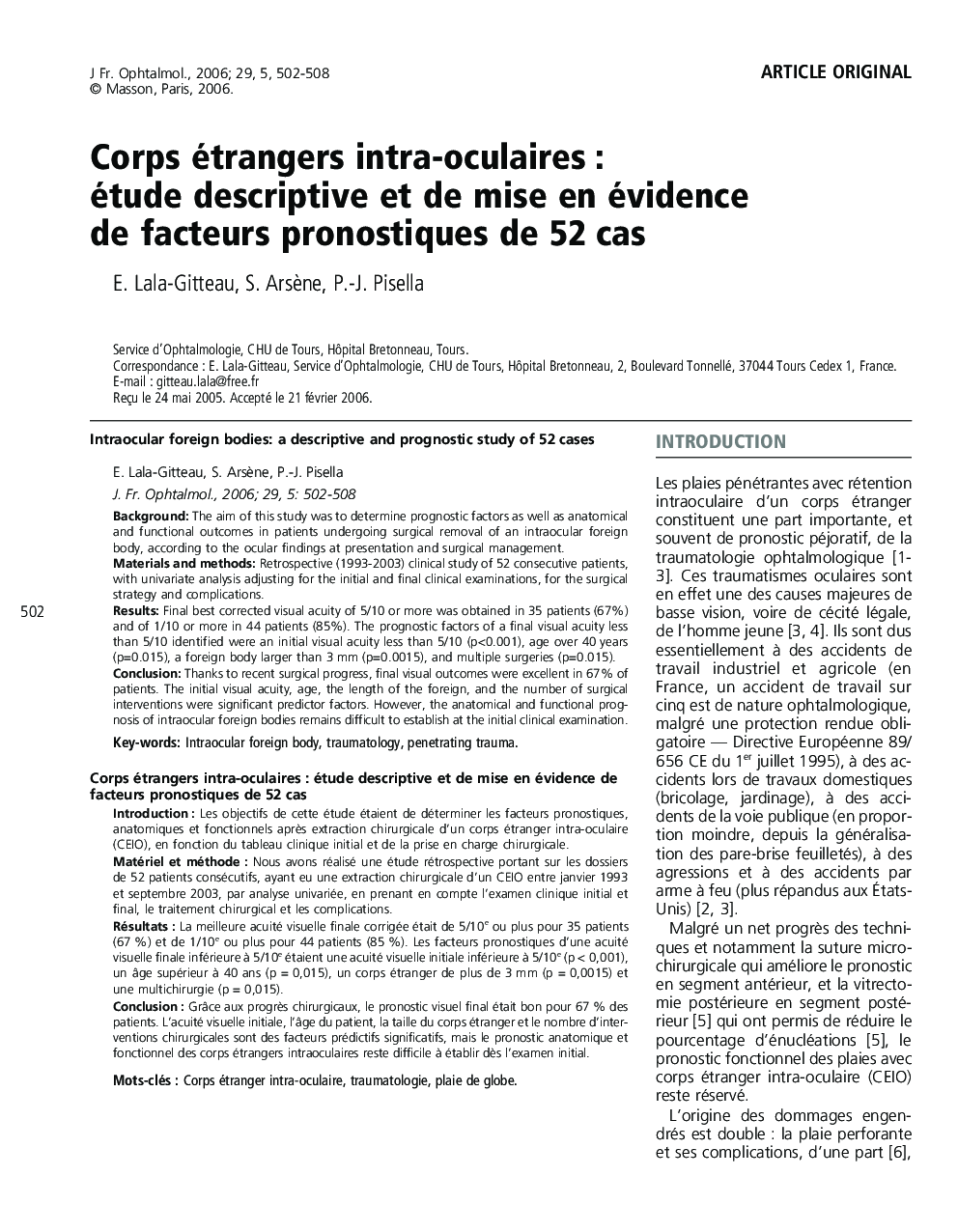| کد مقاله | کد نشریه | سال انتشار | مقاله انگلیسی | نسخه تمام متن |
|---|---|---|---|---|
| 4025431 | 1262353 | 2006 | 7 صفحه PDF | دانلود رایگان |

IntroductionLes objectifs de cette étude étaient de déterminer les facteurs pronostiques, anatomiques et fonctionnels après extraction chirurgicale d'un corps étranger intra-oculaire (CEIO), en fonction du tableau clinique initial et de la prise en charge chirurgicale.Matériel et méthodeNous avons réalisé une étude rétrospective portant sur les dossiers de 52 patients consécutifs, ayant eu une extraction chirurgicale d'un CEIO entre janvier 1993 et septembre 2003, par analyse univariée, en prenant en compte l'examen clinique initial et final, le traitement chirurgical et les complications.RésultatsLa meilleure acuité visuelle finale corrigée était de 5/10e ou plus pour 35 patients (67 %) et de 1/10e ou plus pour 44 patients (85 %). Les facteurs pronostiques d'une acuité visuelle finale inférieure à 5/10e étaient une acuité visuelle initiale inférieure à 5/10e (p < 0,001), un âge supérieur à 40 ans (p = 0,015), un corps étranger de plus de 3 mm (p = 0,0015) et une multichirurgie (p = 0,015).ConclusionGrâce aux progrès chirurgicaux, le pronostic visuel final était bon pour 67 % des patients. L'acuité visuelle initiale, l'âge du patient, la taille du corps étranger et le nombre d'interventions chirurgicales sont des facteurs prédictifs significatifs, mais le pronostic anatomique et fonctionnel des corps étrangers intraoculaires reste difficile à établir dès l'examen initial.
BackgroundThe aim of this study was to determine prognostic factors as well as anatomical and functional outcomes in patients undergoing surgical removal of an intraocular foreign body, according to the ocular findings at presentation and surgical management.Materials and methodsRetrospective (1993-2003) clinical study of 52 consecutive patients, with univariate analysis adjusting for the initial and final clinical examinations, for the surgical strategy and complications.ResultsFinal best corrected visual acuity of 5/10 or more was obtained in 35 patients (67%) and of 1/10 or more in 44 patients (85%). The prognostic factors of a final visual acuity less than 5/10 identified were an initial visual acuity less than 5/10 (p<0.001), age over 40 years (p=0.015), a foreign body larger than 3 mm (p=0.0015), and multiple surgeries (p=0.015).ConclusionThanks to recent surgical progress, final visual outcomes were excellent in 67% of patients. The initial visual acuity, age, the length of the foreign, and the number of surgical interventions were significant predictor factors. However, the anatomical and functional prognosis of intraocular foreign bodies remains difficult to establish at the initial clinical examination.
Journal: Journal Français d'Ophtalmologie - Volume 29, Issue 5, May 2006, Pages 502-508